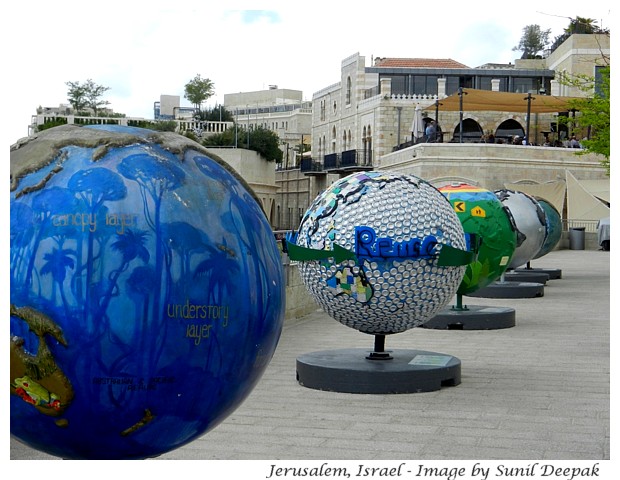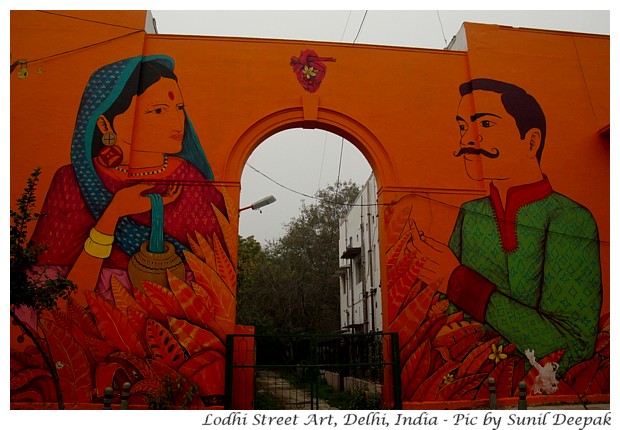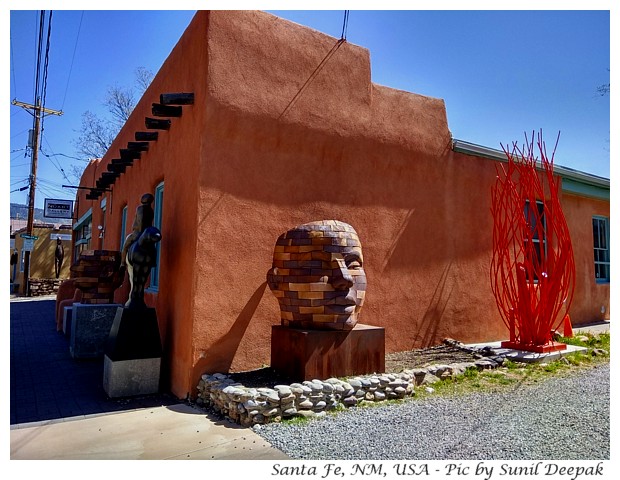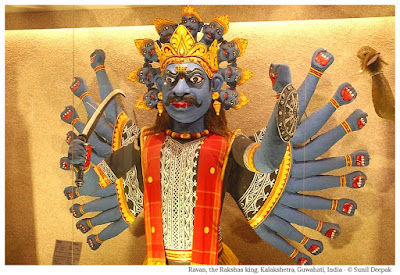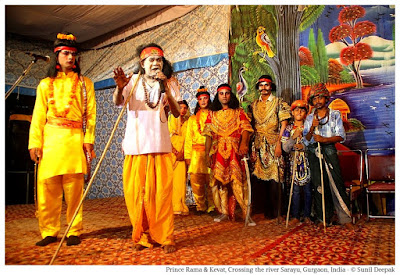Afterwards, thinking about that discussion made me ask myself –
(1) What kind of norms and rules they had in ancient India which guided the settling-down of different outside communities, to ensure harmony with the pre-existing communities already living there?
(2) Another question in my mind was – how were those old Indian norms and rules different from the ideas of secularism today?
My questions reflected the situation in Europe, where we are seeing a kind of popular backlash against immigrants and refugees. Thus, I was asking myself, can there be something we can learn from the experiences of inter-religious harmony in India?
This post is a reflection on the theme of secularism and inter-religious harmony.
Experiences of inter-religious harmony depend upon how the different groups co-exist together in the community. The old proverb, "Live in Rome like the Romans do", indicated the ideals about inter-religious harmony in the west. We don't have similar proverbs in India, becaue it was and is guided by philosophies that accepts a diversity of beliefs.
The western ideas of secularism were defined at the time of theocratic state, when the Christian church held both the state and the religious powers. Secularism's goal was to separate the religious powers from the state powers. However, today most discussions about secularism are about how the Governments deal with and treat persons of different cultures & religions among their populations. These ideas developed in the West, are today seen as universal by a lot of persons, also in India.
I feel that these two ways of thinking, the traditional ideas in India and pagan cultures about inter-religious harmony and those of the secularism, are different though we do not have a clear understanding about those differences. For example, I think that the ideas of secularism are idealistic, they are about how progressive persons would like to see multi-religious societies and are focused more on safeguarding the rights of minorities, which are seen as weak and oppressed. On the other hand, the ideas of inter-religious harmony are more pragmatic and focus on a balance of powers between the groups, in which the majorities often dominate but are respectful of the minorities.
I also think that today most well-educated persons including academics, thinkers, writers and progressives, look at events in our societies mainly through the prism of secularism. On the other hand, most ordinary persons, continue to use the lens of inter-religious harmony. In the communities, there can be a mismatch between the two.
My questions reflected the situation in Europe, where we are seeing a kind of popular backlash against immigrants and refugees. Thus, I was asking myself, can there be something we can learn from the experiences of inter-religious harmony in India?
This post is a reflection on the theme of secularism and inter-religious harmony.
Ideas of Inter-Religious Harmony & Secularism
There are some fundamental differences between the concepts of inter-religious harmony and secularism. Inter-religious harmony is about how different groups live together while secularism is a state policy. However, the two concepts are inter-related and influence each other.Experiences of inter-religious harmony depend upon how the different groups co-exist together in the community. The old proverb, "Live in Rome like the Romans do", indicated the ideals about inter-religious harmony in the west. We don't have similar proverbs in India, becaue it was and is guided by philosophies that accepts a diversity of beliefs.
The western ideas of secularism were defined at the time of theocratic state, when the Christian church held both the state and the religious powers. Secularism's goal was to separate the religious powers from the state powers. However, today most discussions about secularism are about how the Governments deal with and treat persons of different cultures & religions among their populations. These ideas developed in the West, are today seen as universal by a lot of persons, also in India.
I feel that these two ways of thinking, the traditional ideas in India and pagan cultures about inter-religious harmony and those of the secularism, are different though we do not have a clear understanding about those differences. For example, I think that the ideas of secularism are idealistic, they are about how progressive persons would like to see multi-religious societies and are focused more on safeguarding the rights of minorities, which are seen as weak and oppressed. On the other hand, the ideas of inter-religious harmony are more pragmatic and focus on a balance of powers between the groups, in which the majorities often dominate but are respectful of the minorities.
I also think that today most well-educated persons including academics, thinkers, writers and progressives, look at events in our societies mainly through the prism of secularism. On the other hand, most ordinary persons, continue to use the lens of inter-religious harmony. In the communities, there can be a mismatch between the two.
Understanding the Norms of Inter-Religious Harmony in India
The first Christian and Jew Communities came and settled near the coastal areas of south India about 2000 years ago. When Islam arrived in the middle-east, other migrants like Parsi, Baha'i and Armenians arrived in India. Over the centuries, different waves of immigrants from India and abroad also arrived and settled here. Most of these communities prospered and with time, their numbers increased. Till a couple of decades ago, this was a dominant narrative about India, which accepted that the Indic religions were open to people of other religions and welcomed them.During the recent years, gradually the openess and welcoming of Indic religions has been replaced with dominent narratives about "militant and violent Hinduism", especially in relation to the relations with Muslims. I think that this change in narratives does not express a real change about the way Indic religions look at different religions but has other origins.
I believe that it will be useful to understand the different ways in which the Indic religions dealt with refugees arriving in India, who belonged to other religions.
For example - what kind of rules were made by the local kings to accept the persons belonging to different cultural and religious communities, to ensure religious harmony? What do accounts of foreign visitors to India over the centuries tell us about this theme?
How are those older norms and rules, similar to and different from the ideas of secularism dominant today? I searched online but, apart from some generic mentions of Ashoka’s edict and Akbar’s rule, I could not find any academic papers or research work that looked at and analysed the older norms and rules to foster inter-religious harmony in India.
From those experiences what lessons I can draw regarding inter-religious harmony? I think that the first lesson would be that we can have our own religious beliefs but we must have equal respect for other people to have different beliefs - thus reciprocal or mutual respect is fundamental in ensuring harmony. One sided respect, expecting others to respect your ideas and insisting that only your ideas are correct and must be applied universally does not lead to harmony. This mutual respect should be explicit - for example, it can be expressed by participating in each other's special moments such as festivals.
There are only a few countries in the world which have long histories of multi-religious societies. India is one of them where today the religious minorities are made of more than 150 million persons. Jerusalem is another city that comes to mind, which has a significant population of persons of different religions, though it has faced much greater religious strife.
I find some ideas of secularism a little problematic. For example, many believe that secularism means recognising that we all belong to different religions and we should take care to not to offend the persons of other religions by talking about our religious customs and festivals. So, you are not supposed to say “Happy Christmas” to non-Christians or “Eid Mubarak” to non-Muslims. You are not supposed to have Christmas trees in public places and are supposed to make only generic greetings like “Seasons’ greetings” to persons of other religions. I think that this way of thinking, it says that my religious identity is fragile and can be easily offended if any ideas of other religions come near me.
I think that a part of the populist backlash is because of the way some such secularist ideas have been perceived by people. Often when someone does not agree with any of these ideas, there are no spaces for dialogue and discussion as these persons insist that the only acceptable way to live is their way.
How are those older norms and rules, similar to and different from the ideas of secularism dominant today? I searched online but, apart from some generic mentions of Ashoka’s edict and Akbar’s rule, I could not find any academic papers or research work that looked at and analysed the older norms and rules to foster inter-religious harmony in India.
Learning from Personal Experiences of Religious Harmony
I grew up in a multi-religious environment with the idea that our religions were an opportunity to have fun and enjoy the different customs & festivals. On Eid day, our Muslim neighbours prepared sweet sewaiyan (vermicelli) and brought to us, just like on Deewali and Holi, we shared our sweets with them. On the Christmas eve, I accompanied a friend to the mid-night mass in the cathedral, while he was equally enthusiastic about playing with the colours of Holi. On the Gurupurab day, all of us woke up early to get a glass of Kachi lassi from the processions of the Sikhs.From those experiences what lessons I can draw regarding inter-religious harmony? I think that the first lesson would be that we can have our own religious beliefs but we must have equal respect for other people to have different beliefs - thus reciprocal or mutual respect is fundamental in ensuring harmony. One sided respect, expecting others to respect your ideas and insisting that only your ideas are correct and must be applied universally does not lead to harmony. This mutual respect should be explicit - for example, it can be expressed by participating in each other's special moments such as festivals.
There are only a few countries in the world which have long histories of multi-religious societies. India is one of them where today the religious minorities are made of more than 150 million persons. Jerusalem is another city that comes to mind, which has a significant population of persons of different religions, though it has faced much greater religious strife.
The Ideas of Secularism
I think that secularism is interpreted very differently from the ideas of religious harmony that I had learned. Often, it means special protection of minorities.I find some ideas of secularism a little problematic. For example, many believe that secularism means recognising that we all belong to different religions and we should take care to not to offend the persons of other religions by talking about our religious customs and festivals. So, you are not supposed to say “Happy Christmas” to non-Christians or “Eid Mubarak” to non-Muslims. You are not supposed to have Christmas trees in public places and are supposed to make only generic greetings like “Seasons’ greetings” to persons of other religions. I think that this way of thinking, it says that my religious identity is fragile and can be easily offended if any ideas of other religions come near me.
I think that a part of the populist backlash is because of the way some such secularist ideas have been perceived by people. Often when someone does not agree with any of these ideas, there are no spaces for dialogue and discussion as these persons insist that the only acceptable way to live is their way.
I don’t think that the cultural and religious majorities can be silenced by impositions, especially if they perceive them as unjust. Rather, it is a recipe for building rage, which can also explode in backlashes and violence. A process of open dialogue and debates around norms for inter-religious harmony are needed.
Personally, I also feel that we need to study the explicit and implicit traditional norms and rules of communities which govern co-existence of persons of different cultures and religions. It is possible that some of these norms and rules would be discriminatory, and there needs to be a discussion about them with communities. Using secularism as an ideology for protection of minorities can be imposed by law but it will not lead to inter-religious harmony.
Conclusions
I have to confess that my ideas on this subject are not very clear. This post is my way of starting a personal reflection on this theme. They are very much influenced by my growing up surrounded by persons of different religions in India, while the secular concerns dominating many of the discussions seem to me like playing games of identity-victimhood.The ideas of secularism are relatively new while for centuries people of different cultures and religions have inter-mingled and lived together. India has many examples of inter-religious harmony going back to hundreds of years. We should not ignore the lessons from those experiences. Secularism should not become a way to protect the fundamentalist and ortodox ideas of some.
I believe that there is a need for serious studies to understand the kind of strategies used in different epochs in India and in other parts of the world, that allowed long periods of inter-religious harmony and compare them with the modern ideas of secularism, to look at their differences, similarities, challenges and advantages. Such a critical dialogue will be critical for mixing of people in the globalised world.
*****
Note: The pictures used with this post are from an exhibition of globes in old Jerusalem, a place where Jews, Christians, Muslims and Baha'i have their holy land and where inter-religious harmony faces a lot of challenges.
I believe that there is a need for serious studies to understand the kind of strategies used in different epochs in India and in other parts of the world, that allowed long periods of inter-religious harmony and compare them with the modern ideas of secularism, to look at their differences, similarities, challenges and advantages. Such a critical dialogue will be critical for mixing of people in the globalised world.
*****
Note: The pictures used with this post are from an exhibition of globes in old Jerusalem, a place where Jews, Christians, Muslims and Baha'i have their holy land and where inter-religious harmony faces a lot of challenges.
*****
#interreligiousharmony #secularism #india #jerusalem #secularism



